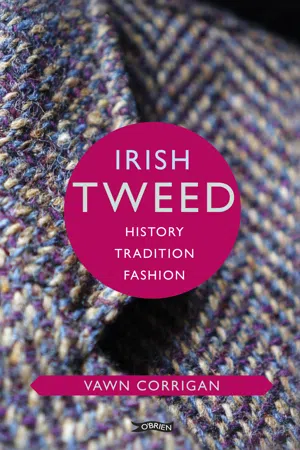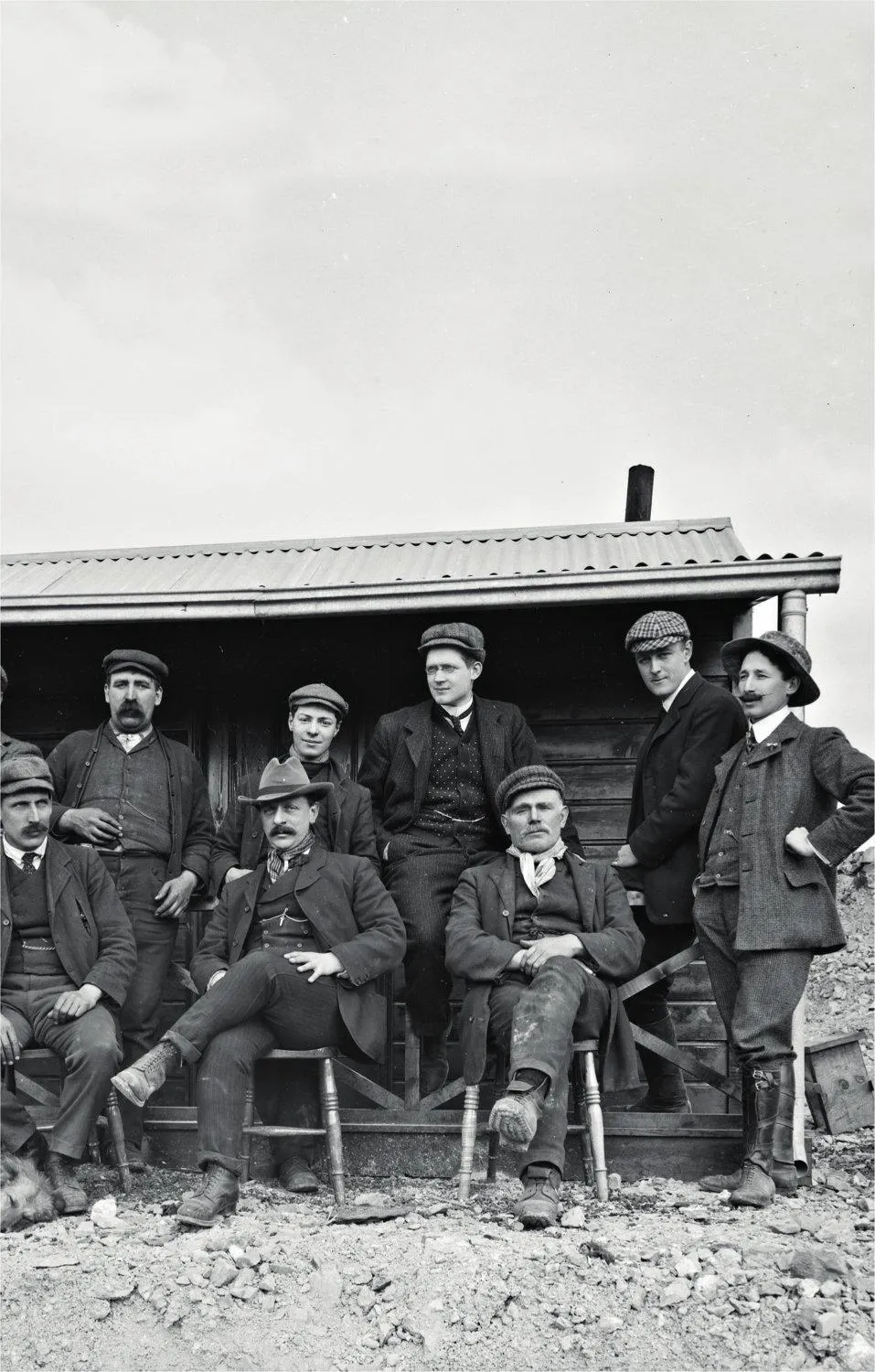
- 192 pages
- English
- ePUB (mobile friendly)
- Available on iOS & Android
eBook - ePub
About this book
'To be human is to be involved with cloth.'
Irish Tweed explores the history, the traditions, the patterns,
the fashions and the legacy of Ireland's distinctive, natural woven fabric.
Arising from ancient woven traditions of brat (cloak), léine (tunic), linen and poplin, tweed has evolved and reinvented itself many times to weave its beautiful lasting way into our future fashions and psyche.
Frequently asked questions
Yes, you can cancel anytime from the Subscription tab in your account settings on the Perlego website. Your subscription will stay active until the end of your current billing period. Learn how to cancel your subscription.
At the moment all of our mobile-responsive ePub books are available to download via the app. Most of our PDFs are also available to download and we're working on making the final remaining ones downloadable now. Learn more here.
Perlego offers two plans: Essential and Complete
- Essential is ideal for learners and professionals who enjoy exploring a wide range of subjects. Access the Essential Library with 800,000+ trusted titles and best-sellers across business, personal growth, and the humanities. Includes unlimited reading time and Standard Read Aloud voice.
- Complete: Perfect for advanced learners and researchers needing full, unrestricted access. Unlock 1.4M+ books across hundreds of subjects, including academic and specialized titles. The Complete Plan also includes advanced features like Premium Read Aloud and Research Assistant.
We are an online textbook subscription service, where you can get access to an entire online library for less than the price of a single book per month. With over 1 million books across 1000+ topics, we’ve got you covered! Learn more here.
Look out for the read-aloud symbol on your next book to see if you can listen to it. The read-aloud tool reads text aloud for you, highlighting the text as it is being read. You can pause it, speed it up and slow it down. Learn more here.
Yes! You can use the Perlego app on both iOS or Android devices to read anytime, anywhere — even offline. Perfect for commutes or when you’re on the go.
Please note we cannot support devices running on iOS 13 and Android 7 or earlier. Learn more about using the app.
Please note we cannot support devices running on iOS 13 and Android 7 or earlier. Learn more about using the app.
Yes, you can access Irish Tweed by Vawn Corrigan in PDF and/or ePUB format, as well as other popular books in Design & Fashion Design. We have over one million books available in our catalogue for you to explore.
Information
Chapter One
A Feel for Tweed
‘Pure wool Irish tweed is a sensual creation; it appeals to our tactile urges.’
Vawn Corrigan
Tweed is an adaptable fabric that offers warmth, insulation and a degree of weatherproofing. It is a relatively loose weave, beloved by designers for its drape, and by those who wear it for its ability to mould itself to the body without losing its shape. As a natural woollen textile, it has a breathable quality. Before the advent of high-performance fabrics such as Gore-Tex, it was considered optimum for outdoor wear for activities such as mountaineering, horse riding and golfing.
Today we have numerous choices of fabrics. Our lifestyles have changed; we have public transport, cars and central heating. Irish tweed has got softer and lighter in response. The sorts of yarns, or threads, used in weaving have changed. While once it was most associated with outdoor clothing, its uses have expanded greatly. Stout and heavier tweeds are in demand, particularly for headwear, bags, coats and waistcoats, but the range is such that a designer may choose Irish tweed for even the lightest evening dress. It remains a casual cloth, unlike the sleek worsted wool fabrics you might recognise in formal suits. It has also become a firm favourite in homeware design, where it is prized for its durability and the wonderful textures it offers. The reason we choose tweed is primarily for the aesthetic. While some weaving is all about complexity, tweed has a kind of honest, simple appeal. Colour and texture are its two supreme features.
TWEED’S ORIGINS
The word ‘tweed’ is generally defined in dictionaries as a coarse woollen cloth handwoven along the western seaboard of Ireland, England and Scotland. Irish tweed has outgrown this definition; it is no longer coarse or necessarily handwoven.
There is some confusion about the origin of the word. There is a river Tweed on the border between Scotland and England, which historically was the location for many textile mills; thus it was suggested that the cloth had been named after the river. However, it is generally agreed that the word came into use when an English clerk mistakenly recorded ‘tweel’ as ‘tweed’ in 1826. Tweel is the Scottish word for twill, a simple weaving pattern in common usage for several hundreds of years in Ireland and Scotland before this time.
Despite similarities between the weaving traditions, Irish tweed is not of Scottish origin. It has had its own distinct and ancient path.
HOMESPUN AND TWEED
Homespun is the forerunner of our modern tweed. The name gives the clue to its manufacture; the entire sequence which moved the wool from local sheep onto people’s bodies was carried out as a domestic craft. Making homespun cloth was so labour-intensive that people did not have extensive wardrobes as they currently do. In nineteenth-century Ireland, it would have been usual for many to have just two sets of clothing: one for everyday wear and one for ‘Sunday best’.

Richly textured pure wool tweeds created by Magee 1866.
Girls’ skirts were made with folds to be let down as they grew, the seats of men’s trousers were looser for working and everyone’s clothes were patched to ensure that they lasted as long as possible. Irish people’s everyday clothing was made from homespun cloth for centuries. It was so ubiquitous that the terms ‘homespuns’ and ‘clothes’ were interchangeable.
The primary difference between homespuns and contemporary tweed lies in the yarns used to weave the cloth. In wool terms, the word ‘handle’ refers to the feel of the wool. The year-round damp in Ireland means that the breeds of sheep which thrive best produce coarse handle fleece more suited to household insulation or carpets than wearable garments. Homespun was a rough fabric made from this fleece. The practice of bringing other breeds from different countries and importing softer handle wools to combine with local wool has been ongoing for well over a hundred years. Contemporary Irish garment tweed is softer than homespun and early tweed. The texture may come as a surprise; there is nothing scratchy or stiff about it. It has a delicious yielding quality. The feel of one hundred percent Irish tweed cannot be replicated by artificial fibres.
THE RAW MATERIAL
Every metre of tweed begins with a sheep grazing on a field or hillside. Once sheared, their fleece is the natural, versatile raw material for weaving. The sorts of fleeces we use have changed over time in an effort to get a softer handle. To get the right balance of softness and structure lambswool may be combined with adult wool from various sheep breeds. When fleeces from different sheep are combined it is termed crossbred wools. This is the most common sort of yarn used in today’s Irish tweed. When you see ‘Irish wool’ on a label it may refer to Irish-spun wool, rather than wool of one hundred percent Irish origin. Irish wool continues to be important in tweed; it has the character that softer wools, such as merinos, lack. Although the prices that it fetches do not incentivise its production, there is a resurgence of interest in the traceability and provenance of wool, which has led to a rise in interest in Irish wools, as will be seen later.

Men from Bonmahon Copper Mines in Waterford showing woollen textiles and caps in everyday menswear at the start of the twentieth century.

Working with pure Irish wool at Cushendale Woollen Mills, in County Kilkenny.
CARDING AND SPINNING YARNS
While technology has altered over the years, the essential steps which go into making a woollen yarn for weaving tweed remain unchanged. Bales of one hundred percent natural raw wool are taken in and the wool is opened and scoured. Scouring means cleaning and preparing. After this it may be dyed, washed and dried, and oiled before teasing to open out the fibres. The wool is then carded to align the fibres and ready it for spinning. Carding is rather like brushing hair; the addition of oil stops the wool from snapping. After carding the wool is so light and soft it most resembles strings of candyfloss.
Carding readies the fleece for spinning. Archaeological digs show that spinning yarns using drop spindles predates the use of the spinning wheel. Once their use was established, spinning wheels scarcely changed through the centuries.

Before machinery, carding was done by hand using two paddles rather like flat hairbrushes. To ease the tedium, sometimes there were ‘carding parties’ where people would card together while chatting and singing songs.
In Ireland, spinning was usually women’s work within the home. When there were large families to clothe, the spinning wheels were seldom still. Consequently, the ...
Table of contents
- Title Page
- Dedication
- Contents
- Introduction: A Long Tradition
- Chapter One: A Feel for Tweed
- Chapter Two: Saints and Rebels
- Chapter Three: Land of Wool
- Chapter Four: Patriotic Cloth
- Chapter Five: From Donegal to Oxford Street
- Chapter Six: The Gaelic Revival
- Chapter Seven: Hand Weaving Steps Towards Art
- Chapter Eight: Irish Tweed – The Headline Act
- Chapter Nine: The Call of Irish Tweed
- Chapter Ten: Changing Times
- Chapter Eleven: Tweed – ‘The Most Valuable and Brilliant Facet’
- Chapter Twelve: Riding the Waves
- Chapter Thirteen: Days of Resurgence
- Chapter Fourteen: Living Legacy
- A Final Word
- Selected Resources
- Picture Credits
- Acknowledgements
- About the Author
- Copyright